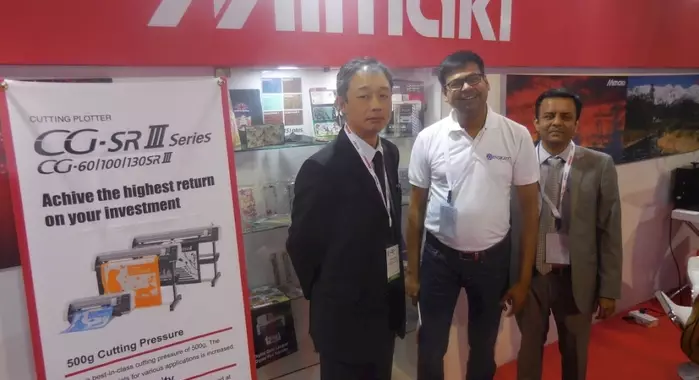High growth rate for digital textile print in India
The World Textile Information Network estimates that the digital textile printing has a 25% growth rate. On the eve of Gartex at 27 to 29 August at Pragati Maidan in Delhi, Rahul Kumar says textiles are a very strong segment in India and we will spot some good trends at the show.
18 Aug 2016 | By Rahul Kumar
The buzz word in print is, digital applications for textiles. More and more shows, from Fespa to Media Expo to Gartex are showcasing the strength of digital print with textiles. The reason is obvious: size plus growth.
Smithers Pira estimates a total of 384 million square metres of fabric being printed digitally via dye sublimation up to Q1 2016, having grown by 18.4% in the past year 2015-16. This is set to rise to 892 million square metres in 2021.
Sam Gulve of EFI who is based in the tech company's impressive Bengaluru-centre says, "The textile printing is a 7.5 billion dollar market, and is projected to grow more than 34% worldwide, providing outstanding opportunities." But he hastens to add, "The actual number should be much higher and the biggest impact shall be in India and China."
Fespa's survey says textile print growth in graphics, garment, decor and industrial markets is the big shift in the future. The initial trends were: inkjet was used for prototyping and one-offs, as the time and cost of setting up screens made inkjet a better value. With the advent of customization and more efficient production equipment, digital printing is becoming mainstream.
The textile printing industry represents 30 billion square metres of material volume on an annual basis worldwide. The data indicated that after a decade of advances in digital printing technologies for textile, a miniscule percentage (1%) of India's printed textiles are produced digitally. The majority of digital printing on textiles is done today mainly on polyester fabrics using dye sublimation.
In India, we saw the growth of dye sublimation digital print after 2010, from a low base from 2011 onward.
And so, high profile campaigns like IPL with the IPL shirts were rendered through dye sublimation. These are printed on the Epson Surecolor SC-F6070 and SC-F 7070 with the Epson Ultrachrome DS inks. Developed over a three-year period, Epson UltraChrome DS is a specially-formulated dye-sublimation ink, producing vibrant colours, intense blacks, sharp contours, and smooth gradations. The all-new ink technology, according to Epson, exhibits excellent light and wash fastness, as well as resistance to alkaline and acid perspiration.
Gulve analyses the situation, "Epson printers did well in the last two years mainly because Mimaki was shut down in India." Now Mimaki is re-entering the Indian market - and are getting very aggressive.
The market feedback about Epson is "good for colour, but slow and economically priced." Some clients use this for proofing or sampling. Gulve feels, "We should see conversion of these printers to higher speed printers very soon. When asked about printing on polyesters, he says, "As for polyesters, it is easy to print digitally with low cost sublimation, but cotton and blends is also growing fast with reactive printing; this needs pre coats and washing/steaming, and you can see this mainly in organised sectors; this is growing rapidly as well."
Meanwhile Mimaki which has tied up with Insight Communications for TS models during the Media Expo show in Mumbai will be promoting the printers at Gartex 2016 scheduled from 27 to 29 August at Pragati Maidan in New Delhi.
“Digital technology has changed everything it has touched, including the textile and printing markets,” says Ajay Aggarwal, Insight.

He adds, that the textile industry is one of the world’s largest industries, and it has come a long way. "Women garments are getting more popular, and home furnishing is doing well. The sportswear fluorescent inks are very important and helps to locate the colours in the dark,” says Aggarwal.
Gulve concludes, "EFI's focus has been on soft signage and furnishings for sure, we have developed fabrics locally and also import the best fabrics from George Otto, Germany, for the sign and display segment. We see double digit growth in the near future in this segment. Custom apparel like IPL and custom furnishings, is growing and see digital pigment and dye sub being an important part of this. The market for reactive inks is grown into high volumes, low margins and see bigger players entering this segment with high speed digital equipment soon.
EFI bought Reggiani Macchine and Matan digital printers in 2015. To boost their textile print presence, EFI purchased Optitex, a 2D/3D fashion design and prototyping software developer.
Simultaneously, Epson has also strengthened its position in the industrial digital textile segment with the acquisition of Italian digital printer manufacturer Robustelli.
At Gartex one hopes to see a large number of manufacturers and suppliers focusing on digital textile printing. Visitors will see an abundance of digital textile print kit and applications plus hear from experts in this market sector.











 See All
See All